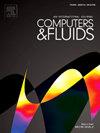Modeling of interfacial two-phase flows via VOF-based LS method with WENO scheme in the finite volume method
IF 2.5
3区 工程技术
Q3 COMPUTER SCIENCE, INTERDISCIPLINARY APPLICATIONS
引用次数: 0
Abstract
The modeling of interfacial two-phase flows involves various fields such as hydraulic engineering, marine engineering, chemical industry, etc., whose difficulty lies in the accurate simulation of the two-phase flow interface. This paper presents a VOF(volume of fluid)-based LS (level set) method with WENO (weighted essentially non-oscillatory) scheme in the finite volume method. The proposed method initializes the LS function by transforming the VOF function, which does not have the characteristics of the distance function yet. Therefore, the next step is to re-distance the transformed LS function by solving the re-initialization equation. For solving the re-initialization equation, the WENO scheme in the finite volume method is employed, providing fifth-order accuracy for the convection term. To validate the proposed VOF-based LS method combined with the WENO scheme, five test cases are presented, including Zalesak's disk, vortex deformation, Rayleigh-Taylor instability, two-dimensional bubble rise, and dam break flow. The numerical results from these interfacial two-phase flow cases demonstrate that the VOF-based LS method with the WENO scheme in the finite volume method can achieve accurate capture of the interface while maintaining excellent mass conservation characteristics.
基于有限体积法WENO格式的基于vof的LS方法模拟界面两相流
界面两相流的建模涉及水利工程、海洋工程、化工等多个领域,其难点在于两相流界面的精确模拟。本文提出了一种基于有限体积法中基于流体体积的LS (level set)方法,并结合WENO (weighted本质非振荡)格式。该方法通过变换不具备距离函数特征的VOF函数来初始化LS函数。因此,下一步是通过求解重新初始化方程来重新距离变换后的LS函数。对于重新初始化方程的求解,采用有限体积法中的WENO格式,对流项具有五阶精度。为了验证所提出的基于vof的LS方法与WENO方案相结合,给出了Zalesak盘、涡旋变形、瑞利-泰勒不稳定性、二维气泡上升和溃坝流5个试验用例。这些界面两相流实例的数值计算结果表明,基于vof的LS方法结合有限体积法中的WENO格式可以在保持良好质量守恒特性的同时实现对界面的精确捕获。
本文章由计算机程序翻译,如有差异,请以英文原文为准。
求助全文
约1分钟内获得全文
求助全文
来源期刊

Computers & Fluids
物理-计算机:跨学科应用
CiteScore
5.30
自引率
7.10%
发文量
242
审稿时长
10.8 months
期刊介绍:
Computers & Fluids is multidisciplinary. The term ''fluid'' is interpreted in the broadest sense. Hydro- and aerodynamics, high-speed and physical gas dynamics, turbulence and flow stability, multiphase flow, rheology, tribology and fluid-structure interaction are all of interest, provided that computer technique plays a significant role in the associated studies or design methodology.
 求助内容:
求助内容: 应助结果提醒方式:
应助结果提醒方式:


